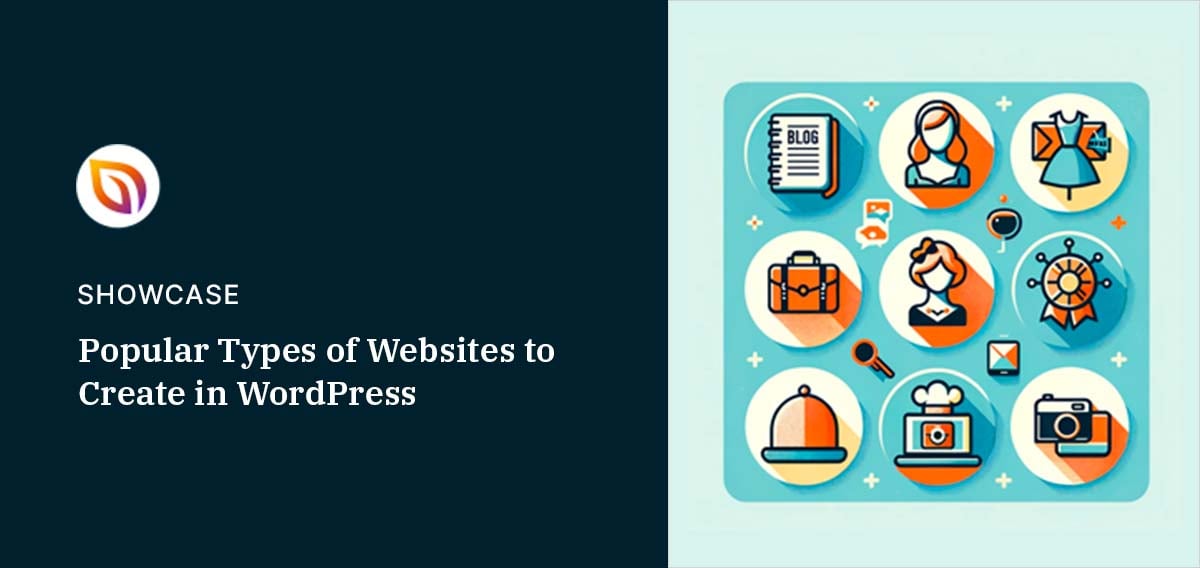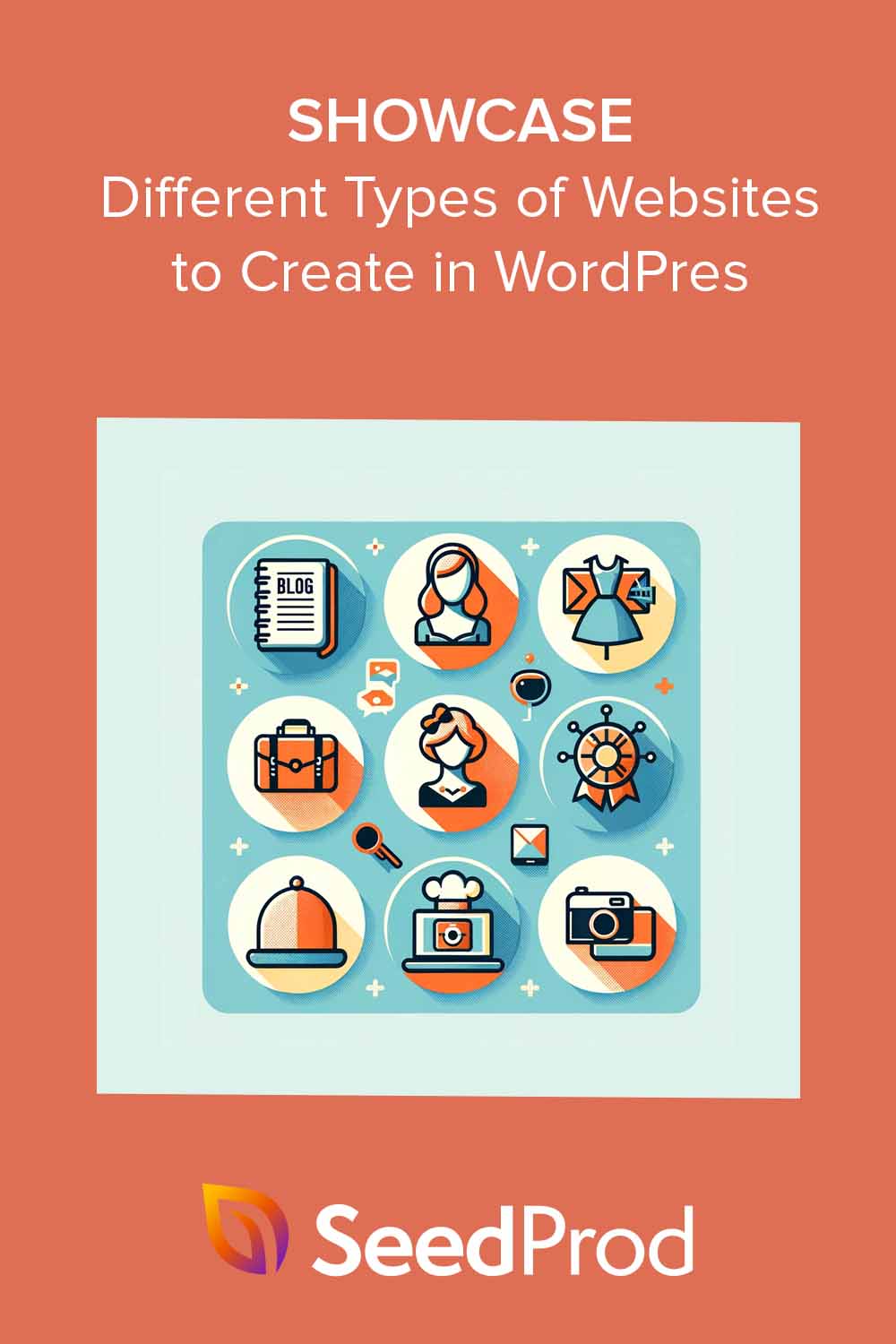If your goal is to build your online presence, a business website is an excellent place to start. It can help you increase brand awareness, establish expertise, and generate business leads and conversions. But a common problem you might face is knowing what types of websites to create. What is the best type of website for your business needs?
We hear you. It’s a question many of our readers ask, and in this guide, we’ll answer it.
Read on to discover the different kinds of websites you can build on WordPress without writing code.
In This Guide:
Why Use WordPress to Build a Website?
Before we dive in, you’re probably wondering why WordPress is our top choice for building any type of website.
The answer is over the years, WordPress has evolved from a simple blogging tool to a powerful content management system that supports virtually any website niche. It’s a key reason why it powers over 43% of all websites.
With WordPress, there’s no need to learn coding languages; everything is pre-designed and customizable. Themes, plugins, and widgets are just a click away, making WordPress an open playground for creativity.
Plus, with a self-hosted WordPress site, you have complete control and ownership of your content, something you don’t get with other website builders.
Syed Balkhi, the brains behind WPBeginner, said in a Tweet:
And we agree 100%.
But we still need to answer our initial question about the types of websites to create. So, let’s dive in and find out.
We can think of building so many types of websites that it would be impossible to fit them all into one post. Instead, we’ve focused on the most popular options businesses use across various niches and industries.
Content-Focused Types of Websites
1. Blogs
Blogs are one of the most popular types of websites where you post content regularly. Most blog websites are informational websites that center on a specific topic or theme and vary from personal reflections to professional advice.
Some popular blog sites include:
- Food blogs
- Personal blogs
- Health and wellness blogs
- Software and technology blogs
- Lifestyle blogs
- Interior design blogs
Blogs usually include text posts, images, and even video content, where readers can leave comments with their thoughts and opinions. They can also feature landing pages that encourage users to subscribe for exclusive content.
Here’s an example from Copyblogger, a content marketing and copywriting blog:
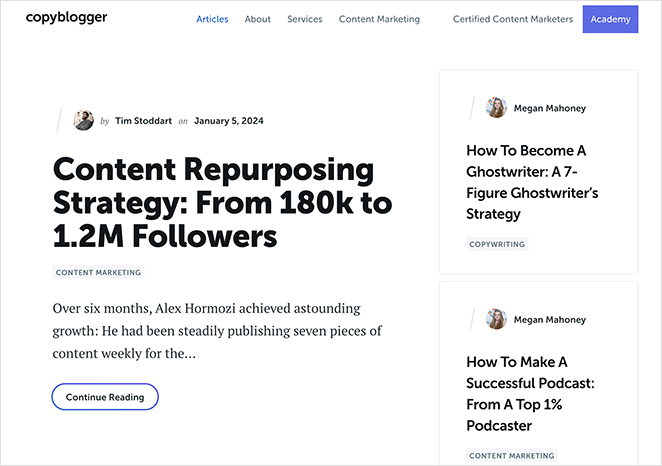
We love the blog’s clean layout that focuses on its content. You can easily browse the grid layout to find the information you need without any distractions. When clicking through to a post, the content is easy to read, well illustrated, and with a minimalist sidebar for easy navigation.
We’ve even written a guide on how to start a mom blog in WordPress.
2. Personal Websites
A personal website is a digital space purely dedicated to you as an individual. This type of website often includes a simple biography, CV, a portfolio showcasing skills, and maybe even a blog section.
You could liken it to a living, breathing resume, with the added benefit of expressing your personality through design and interactive elements. It’s a wonderful way to make a strong digital impression and leave your online footprint for potential collaborators or employers.
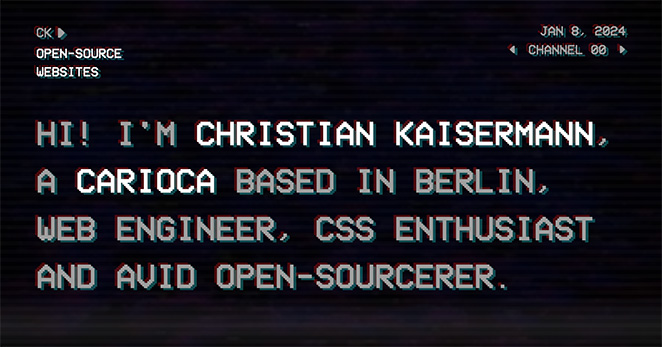
In this example from Christian Kaiserman, you immediately get a sense of his expertise in web engineering from the homepage. His navigation menu works like the channels of an old TV, allowing you to explore his work, skills, and, for fun, different TV channels.
3. News Websites
News websites are common types of websites that typically deliver up-to-date information on current events and trending topics. They primarily publish articles, blog posts, videos, and photo galleries that cover a wide range of subjects such as politics, culture, economy, and more.
The dynamic nature of the content and real-time updates make news websites a popular choice for readers worldwide.
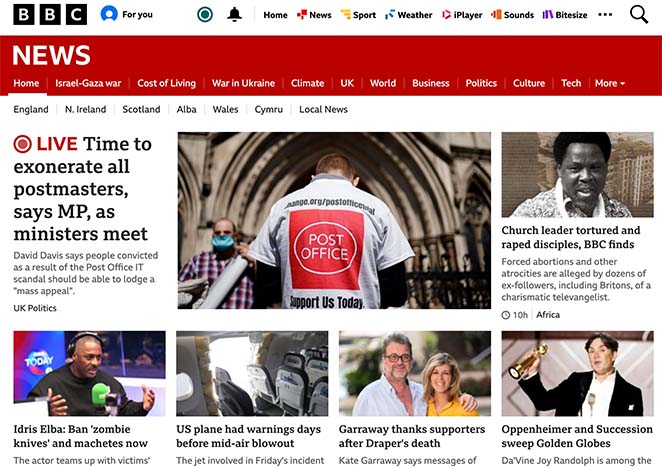
The BBC News website is an excellent example of how news sites are organized. You can use the navigation bar to explore different news topics and browse the grid layout for a snapshot of what you can read in each section.
When clicking through to a full article, you’ll see relevant content in the sidebar, linked throughout the post, and, at the end, designed to keep you browsing the site.
4. Magazine Websites
A magazine website is essentially a digital version of traditional print magazines. They emulate the experience of flipping through a glossy magazine with the added benefits of instant access, interactive features, and real-time content updates.
The type of content they provide is informative, lifestyle, entertainment, or niche-specific, often grouped by issue, similar to physical magazines. They’re ideal for publishers who want to share diverse, rich-media content in a visually appealing, organized way.

Here’s an example from Forbes, a print and digital magazine focusing on business topics. Like news sites, it has an easy-to-navigate grid-style layout with sections for different subtopics.
You’ll also see that some posts are locked behind a paywall that requires a subscription to read. Many magazine sites use this model to monetize their online business.
5. Educational Websites
Educational websites are powerful online resources that allow users to explore knowledge at their fingertips. They cover multiple subjects with educators or students in mind, such as:
- University, school, or daycare sites
- Online learning sites
- Digital libraries
- Language learning websites
These sites typically have features such as online courses, tutorials, educational games, and high-quality resources that offer instruction and materials to users who want to learn more about a subject.
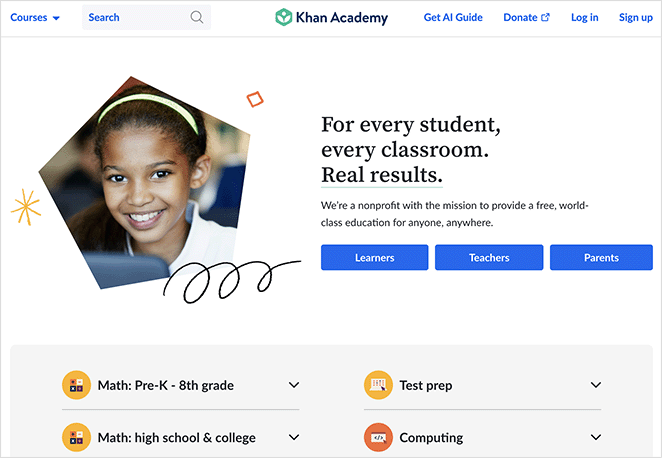
We love Khan Academy’s website for its large range of educational resources. It offers practice exercises, instructional videos, and a personalized learning dashboard that encourages learners to study at their own pace inside and outside the classroom.
6. Social Media Websites
You’re likely familiar with social media sites where individuals, businesses, and communities can interact, share information, and engage with each other. These sites allow you to create user profiles, share posts or updates, and network through private messages or public comment sections.
Popular social media websites include:
- X (formerly Twitter)
- YouTube
The appeal of these sites lies in their ability to create a sense of community and offer the chance to interact in real time.
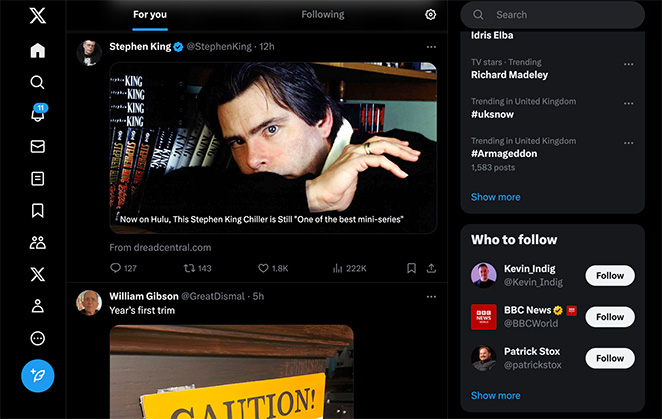
In this example from X, you can see the website design has a feed layout that displays posts and advertisements from people you follow. On the left is your personal navigation bar, while on the right are trending topics, premium upgrades, and friend suggestions.
7. Entertainment Websites
Entertainment sites aim to provide amusement and enjoyment to their visitors. They offer a great escape from the routine, connecting users with content that relaxes and entertains.
These types of websites can include:
- Streaming and online TV
- Animation and comics
- Books and Literature
- Music streaming
- Performing arts
Created to keep their audience coming back for more, entertainment sites can include everything from online games to webcomics or upbeat blog posts.
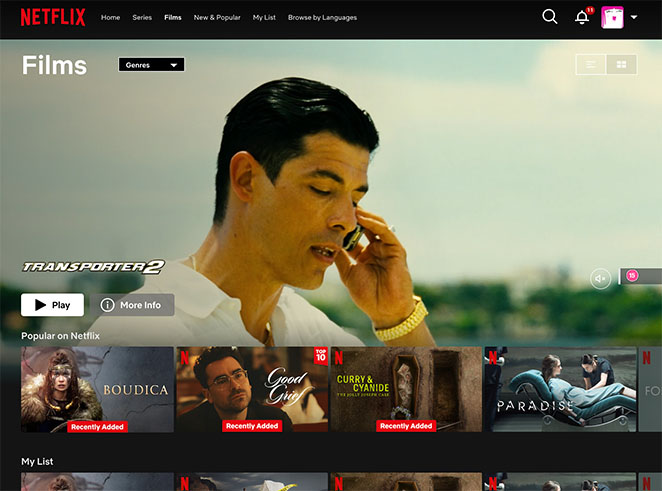
Netflix is probably one of the most popular examples of entertainment sites, offering video and movie streaming for a monthly subscription. Videos are organized by popularity and category, and it even has a watchlist you can personalize with content you plan to watch in the future.
Business and Portfolio Websites
8. Company Websites
A company or business website acts as the digital face of a business, representing its mission, products, services, and values online. It provides a platform for businesses to engage with potential customers, generate leads, and boost their online presence.
Business sites can include:
- Nonprofit websites
- Startups
- Brochure websites
- Agencies
- Online stores
- Event websites
- Crowdfunding
Besides offering information, business sites often include features like a contact form, live chat, call-to-action (CTA), and customer support. It’s an essential tool for any company looking to establish credibility and expand its reach online.
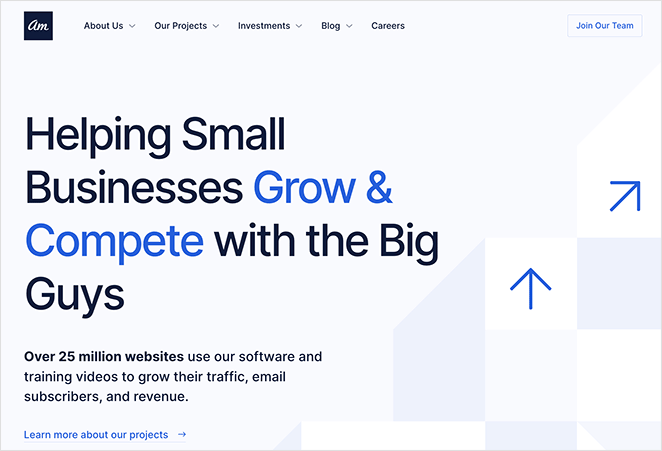
Awesome Motive’s website includes almost all of these features. It has a clear mission statement, links to learn more about its brands, social proof from its customers, and plenty of news and updates.
Here are some more business website examples you can use as inspiration.
9. Portfolio Websites
Portfolio websites are where you can showcase your skills, experience, and creativity to potential clients or employers. They’re like an online resume highlighting your work and demonstrating your expertise and talent.
You can create an online portfolio website if you are an:
- Artist
- Photographer
- Designer
- Writer
- Web developer
- Illustrator
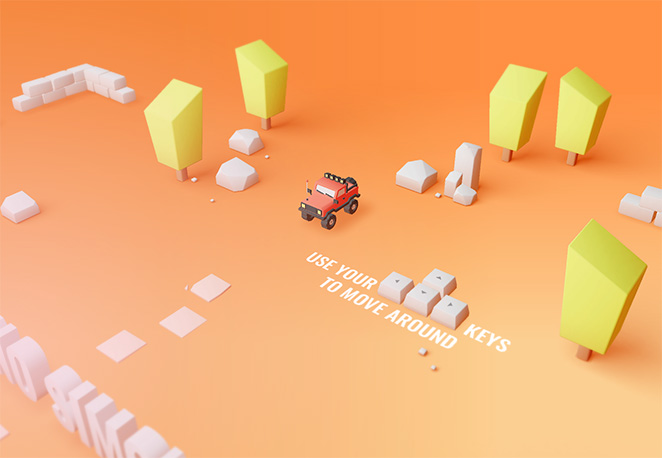
We love creative developer Bruno Simon’s portfolio site. You can drive between his various projects using your WASD keys, transforming a static site into something truly interactive.
Since we’re not the best at keyboard driving, we found this approach slightly frustrating, but it’s still an excellent way to demonstrate your skills in a particular field.
💡 Tip
Launch a custom website in seconds using SeedProd’s AI website builder. Simply provide a brief description of your site, and it will generate a fully custom theme, helping you save time and get online faster.
10. Freelancer Websites
If you’re a freelancer, showcasing your work and attracting clients is a priority. Like portfolios, a freelancer website is your personal online space where you can display your work, list your services, post customer testimonials, and essentially “sell” your skills.
It’s a platform through which clients can understand your work style, gauge your competence, and reach out to collaborate. Essentially, it’s your virtual storefront, open to the world 24/7.
A personal trainer website is a great example of this type of website. You’ll want sections for happy clients, what training you offer, and, of course, your professional credentials.
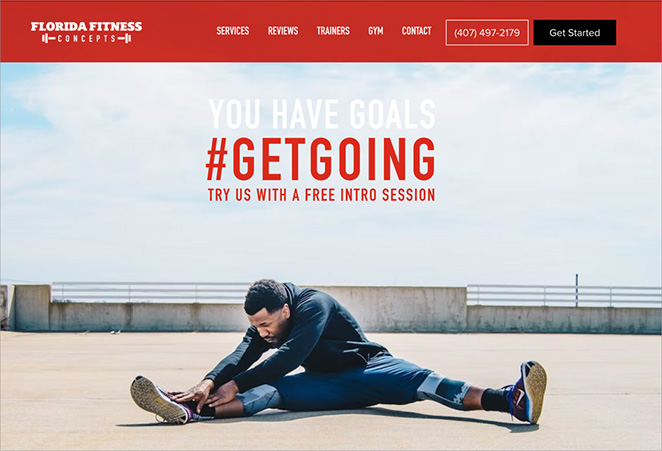
The same is true for copywriting services.
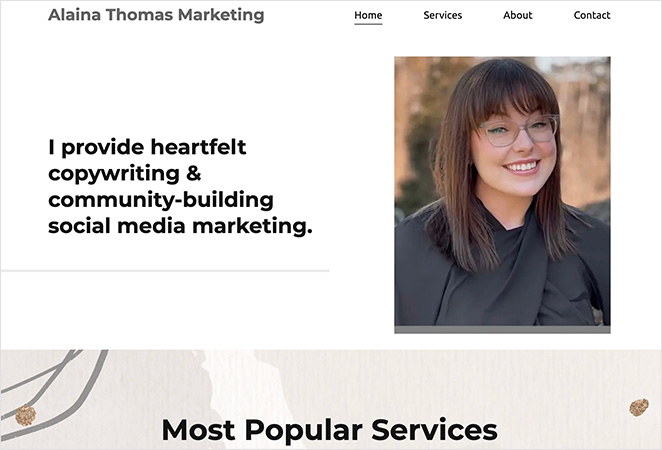
In this example from Alaina Thomas, the web pages demonstrate her marketing and content creation expertise. The web design is user-friendly, with service pages that tell potential clients exactly what they can expect.
11. Consulting Websites
Another type of business website is a consulting website that highlights consulting firms or independent consultant services.
They typically offer solutions for businesses across industries. From management to strategy, technology to HR, these websites explain the consultant’s expertise and unique value proposition and often feature client testimonials.
The main goal is to attract or engage potential customers, showcasing their skills, success stories, and methods, helping them make an informed decision to hire their consulting services.
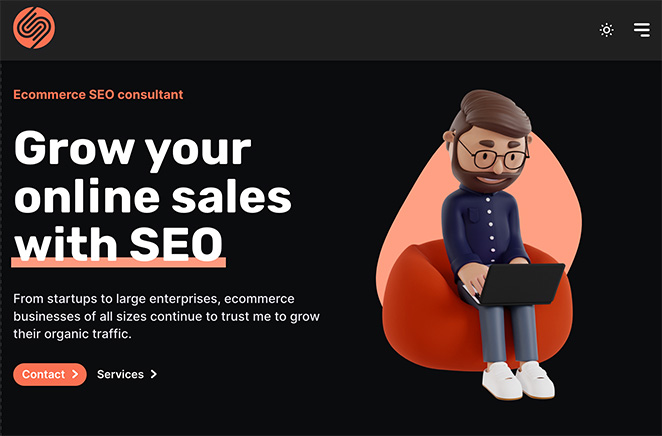
SEO consultant Sam Underwood’s website is an ideal example. He uses clear, direct language that speaks directly to his target audience.
He also supports his claims with customer testimonials, detailed service pages, and a helpful blog with tips and advice.
Service-Oriented Types of Websites
12. eCommerce Websites
Some of the most popular types of service-orientated websites are eCommerce websites. Often serving business-to-customer (B2C) or business-to-business (B2B), these sites allow you to sell goods and services to people over the Internet.
eCommerce sites can include:
- Online marketplaces like Amazon
- eCommerce platforms like Shopify
- Software as a Service (SaaS) websites
- Online retailers
- Affiliate websites
- One page websites selling a single product
They’re virtual storefronts where users can navigate product catalogs, add items to shopping carts, and make purchases safely and securely. Used by millions of businesses worldwide, eCommerce websites are a crucial tool for modern retail.
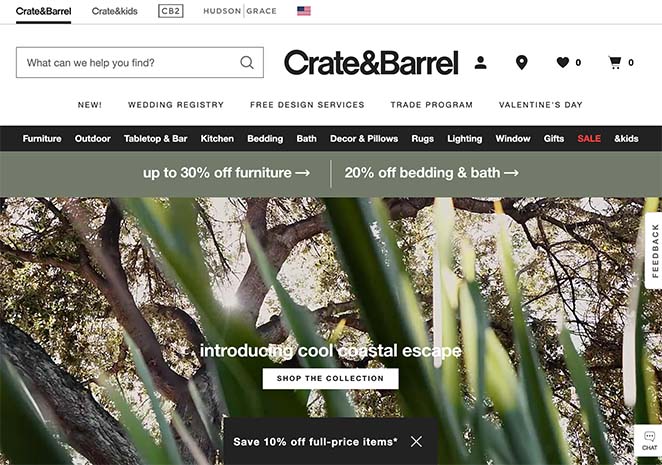
This example from Crate & Barrel does an excellent job of reflecting its brand. The website is light and clean and uses a consistent color scheme throughout.
You can browse products by category, and product pages have filtering options to help narrow your search. The breadcrumbs also play an important part in helping you keep track of where you are on the site.
13. Membership Websites
Like eCommerce sites, membership websites offer exclusive content, products, or services to subscribed members. These sites typically have a login portal for members to access areas restricted to general visitors.
Membership sites act as a platform for individuals or organizations to build a community, share expert knowledge, or even offer a unique service. This could range from a fitness training program to online courses, premium news content, and more.
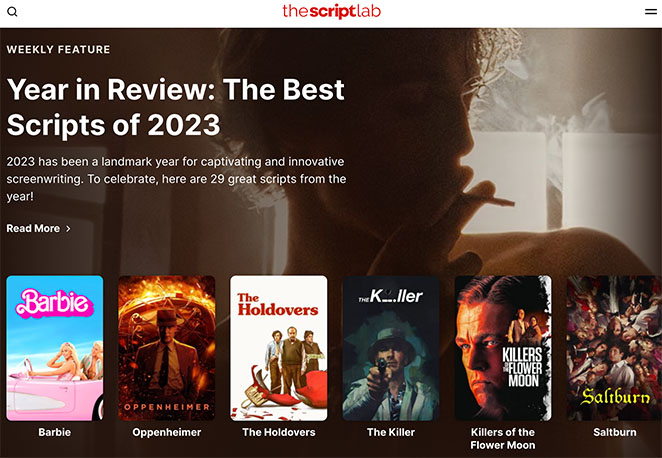
The Script Lab is a website packed with information and advice for scriptwriters. While its articles are free, you’ll need to become a member to access the scripts.
The website itself is easy to navigate, with clear sections and plenty of visual content. For members, it has multiple member levels and a members dashboard for exclusive content.
14. Online Forums
Online forums are open platforms where people can create and join discussions on various topics. These sites are usually broken down into categories and threads that focus on different subtopics.
Some of the most popular forums and web portals are:
- Quora
- StackOverflow
- Craigslist
- GameSpot
- IGN Boards
They’re crucial for promoting dialogue and helping create a strong sense of community among users.
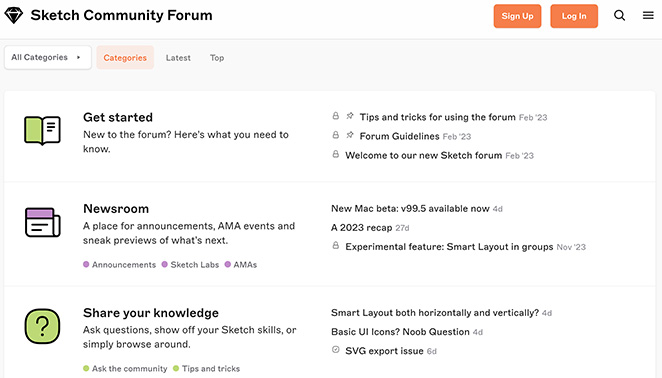
Here’s an example from the Sketch community forum. Users can share their knowledge by creating posts and offering advice to others by leaving their own comments.
15. Community Websites
Community websites are similar to forums in that they bring people together. However, they’re more like a digital town hall or clubhouse, uniting users around a common interest, cause, or activity such as:
- Religion
- Dating and Relationships
- Wikis like Wikipedia
- Philanthropy
- Local areas
- Hobbies
- Holidays
Here, users can get more information about the topic, share ideas, join discussions, and build relationships, creating a vibrant online community.

Mumsnet, for example, is a community website run by parents for parents. The site features helpful parent-related content, including deals, advice, and competitions.
Parents can also post questions and weigh in with their opinions on anything from home and garden topics to childbirth and education.
16. Knowledge Base / Documentation Websites
A knowledge base website is where businesses organize and share important information with their users, customers, or employees. Think of it as a digital library of helpful resources that answers common questions and explains how to use products or services.
These types of websites often include:
- Product documentation
- User guides
- Technical manuals
- FAQs
- Troubleshooting guides
- API documentation
If you run a software company or offer complex services, a knowledge base website is essential for providing customer support and reducing support tickets.
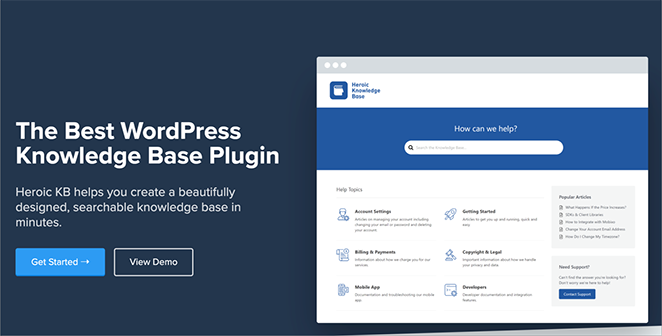
For example, Heroic Knowledge Base makes it easy to create a documentation website in WordPress. You can organize articles by category, add a powerful search feature, and even track which articles are most helpful to your users.
The best part? You can see exactly what information your users are looking for and which articles need improvement. This helps you continuously improve your documentation and provide better support.
How to Create Your Type of Website
By now, you may have a good idea of the type of website you need for your personal or small business project. The next step is to plan how you’ll design and build it in WordPress.
We have several resources that can help you with this.
First, we recommend checking out our guide on how much a WordPress theme costs. A theme or template dictates the style and functionality of your site design, so understanding how much it costs to make or buy one is a good starting point.
After, you can follow our easy guide to creating a WordPress website. It walks you through the essentials, from setting up your web hosting to optimizing your site for search engines.
Before you go live, you can also see our tips on marketing your website before launching. By the time you’ve finished with these resources, you’ll have a website ready to kickstart your online presence and a solid foundation to grow your business.
That brings us to the end of this guide. We hope it helped you find the different types of websites that are best suited to your goals.
Thanks for reading! We’d love to hear your thoughts, so please feel free to leave a comment with any questions and feedback.
You can also follow us on YouTube, X (formerly Twitter), and Facebook for more helpful content to grow your business.

